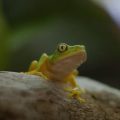Plan your visit to Orchid Family Day!
“Orchids: Amazing Adaptations,” is now on view at the Donald W. Reynolds Center for American Art and Portraiture. Family Day is April 6, 11:30 a.m. 3 p.m.
You will have the opportunity to touch and smell orchids, make a orchid corsage, create a postcard with orchid stamps, pot your own orchid, and more!

Orchid Dendrobium Bardo Rose (courtesy Smithsonian Gardens)
The title of this year’s orchid exhibit, Orchids: Amazing Adaptations, not only refers to the exhibit’s story line – how orchids have adapted to a variety of habitats, climate conditions and other organisms – but also what Smithsonian Gardens’ design team encountered throughout the exhibit’s development and installation. Producing any exhibit requires the coordination of many moving parts and the corralling of multiple players; producing this exhibit required multiple design changes and the ability to navigate the added challenge of a government shutdown. Despite a number of hindrances, we were, able to come together and work to get the job done on a greatly compressed installation schedule.
Orchids: Amazing Adaptations is the 24th annual collaborative exhibit displaying the combined orchid collections of the U. S. Botanic Garden (USBG) and Smithsonian Gardens (SG). Both organizations alternate hosting the exhibit and this year the orchids are on display in the Robert and Arlene Kogod Courtyard of the Smithsonian American Art Museum and National Portrait Gallery. When USBG hosts, the exhibit is held in its conservatory which provides ideal growing conditions as well as a built-in natural background. Because there is no dedicated interior display space for Smithsonian Gardens to call upon, when SG hosts the exhibit it could appear in any one of the Smithsonian museums – each providing a unique backdrop but none having adequate conditions for displaying plants for an extended period of time. Therefore, any exhibit design we create must be, as orchids are, adaptable to a variety of environments.
The unique nature of an orchid exhibit is inherently ever-changing as the plants’ blossoms move through their naturally fleeting presentation. Consequently, the exhibit’s appearance of the exhibit will evolve from week to week as plants are moved in and out of the display. Designing such an exhibit at the Smithsonian must take this constant transformation into account. Planning essentially begins when one exhibit ends and continues over the next two years until the next one is installed. Planning requires securing a venue, forming a design committee and establishing the exhibit’s central theme. A budget is set and the designers are free to create with the resources they’ve been given.
An exhibit’s overall design is usually influenced by one of two factors – a selected theme or a venue. SG chose to embrace the expansive space of the Kogod Courtyard and the surrounding museums’ collections to create a complimentary design. This design included some very large colorful artistic props decorated with flashy renderings of pollinators. At some point, however, the design team felt the opulence of the proposed design ran the risk of overwhelming the magnificence of the orchids and decided the backdrop should be more naturalistic and the setting more subdued. Props and non-flowering plants were still needed to highlight the orchids but when showcasing such amazing creations, less competing color and structure is definitely more. This change was embraced by all.
Bees collecting Perfume from a Tulip orchid
This footage from Jardín Botánico “Las Orquídeas” in Puyo, Ecuador shows orchid bees of the genera Euglossa (metallic green) and Eulaema (yellow, black and brown) collecting perfume from the Tulip orchid Anguloa eburnea. These orchids do not produce nectar to attract pollinators, but fragrances which are collected by male orchid bees (Euglossini) in order to seduce females.
The last of SG’s planning process “adaptations” came during the first week of January, the week that installation of the exhibit was scheduled to begin. The government ordered a shutdown, and SG staff did not return for four weeks. Subsequently we were forced to delay the opening date by two weeks, giving us needed time but cutting the original four week installation schedule in half. We powered through and thanks to an incredible effort from all sections of Smithsonian Gardens, were able to open to the public only two weeks after the originally scheduled opening. The orchids are now on display in their full glory for the next six weeks. Orchids: Amazing Adaptations is truly reflective of the successful weathering of a challenging ride for a well-organized and adaptable crew.
This post was written by Melanie Pyle, horticulturist with Smithsonian Gardens.
Posted: 1 April 2019
-
Categories:
Collaboration , Education, Access & Outreach , Feature Stories







